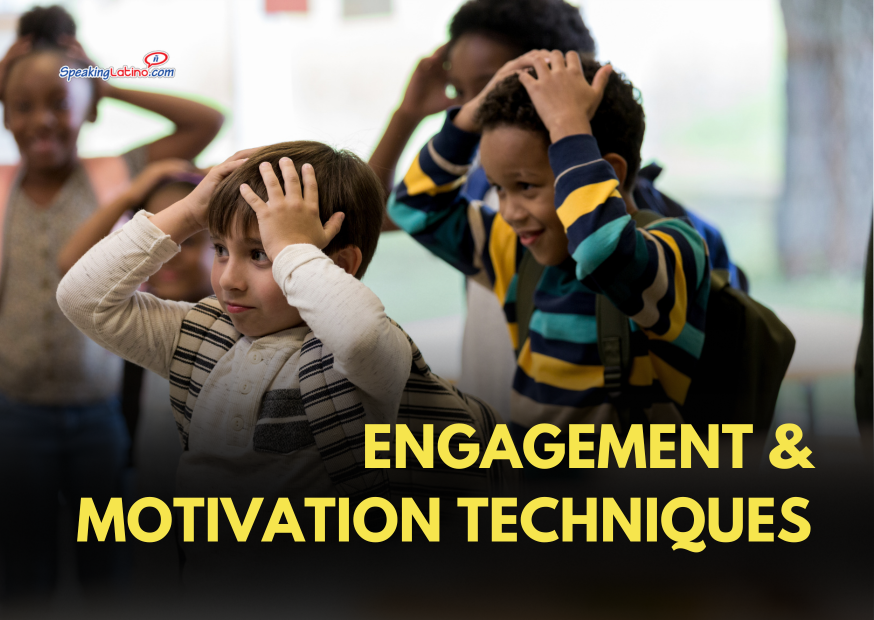
The content of this article is based on the presentation, Engagement and Student Motivation by Norma Jones, which was part of the World Language Teacher Summit.
Promoting Active Participation and Motivation in Language Education
The role of engagement and student motivation in the language learning classroom is pivotal. Fostering a learning environment where students are excited and willing to participate actively can significantly enhance the language acquisition process.
By utilizing a variety of teaching strategies such as games, movement activities, and interactive routines, educators can create an emotionally engaging and intellectually stimulating environment that promotes language acquisition and cultural appreciation.
Game-Based Learning in Language Education
The introduction of a strategic reading game illustrates the potent impact of gamification in the classroom. It is designed to stimulate students’ curiosity and enhance comprehension skills. Students predict, answer, and accumulate points through correct responses, which bolsters both their independent critical-thinking abilities and teamwork skills. The novel addition of playing cards to signify points gamifies the learning experience, converting the classroom environment into a collaborative and competitive arena.
Incorporating Kinesthetic Elements
Kinesthetic learning activities, inspired by seasoned educators who have successfully integrated movement into language instruction, allow students to embody their learning. One such instance is students imitating world art images, which extends beyond the physical enactment to encompass discussion and reflection, thereby adding a cultural layer to linguistic acquisition. By incorporating weekly enjoyment such as "Just Dance" sessions, educators instill a sense of fun that augments the students' associative memory regarding the target language's vocabulary and phrases.
The Power of Music and Art in Language Acquisition
Music holds a unique universal appeal that can bridge gaps between cultures and languages. Integrating music into language instruction through activities where students engage with songs, partake in class-wide musical challenges, and learn new content through song-based methods reinforces language acquisition. By embracing TPR and Simón Dice techniques, educators transform passive listening into a full-fledged sensory experience, solidifying their students' language learning with each melody and beat.
Fostering Empathy and Classroom Community
A healthy learning environment is predicated on the establishment of empathy and inclusivity within the classroom. The practice of daily routines that probe individual students' emotions and implementing a teacher pride wall builds a supportive classroom culture. Involving students in the creation of class norms instills a sense of ownership and collective responsibility, making them more invested in the classroom experience as well as in their learning journey.
Integrating Modern Trends and Technology
Harnessing the capabilities of modern technology can greatly enhance language instruction. Through the use of videos and word clouds, educators are able to present content in a relatable and accessible manner. Recognizing and incorporating the students’ vernacular creates a more intimate and effective mode of communication that encourages student participation and assists in bridging any gaps between educator and learner.
Employing Diverse Interactive Strategies
By blending assorted interaction-driven methodologies such as the "marker game" or SEIS that cater to different learning styles, educators craft an immersive and comprehensive language learning environment. These strategies, focusing on reading, speaking, and writing activities, harmonize enjoyment with meaningful language acquisition, ensuring students feel valued in their educational engagement.
Enhancing Reading Engagement
Reading activities that incentivize comprehensive engagement, like the "lucky reading card game," embody a successful approach to integrating text analysis with the excitement of gaming. The provision of classroom jobs tied to a points system gives students a sense of purpose and motivates them to excel not only in the games played but also in their overall language proficiency.

Reading games stimulate students’ curiosity and enhance comprehension skills.
Creative Storytelling
By prompting students to originate and choreograph their own narratives, educators tap into the rich imaginative resources of the young learners. Assisting students in rewriting these stories to emphasize key linguistic structures not only aids in language acquisition but also deepens their personal connection to the material they are learning.
FAQs About Student Engagement and Motivation
How do different teaching strategies impact student engagement in language learning?
Different teaching strategies can have a significant impact on student engagement in language learning. Here are some ways in which various strategies can influence student engagement:
- Interactive Activities: Incorporating interactive activities such as games, role-plays, and group discussions can make learning more engaging and enjoyable for students. These activities promote active participation and collaboration, keeping students motivated and interested in the language learning process.
- Multimedia Resources: Using multimedia resources like videos, podcasts, and online platforms can appeal to different learning styles and preferences, making the learning experience more dynamic and stimulating. Visual and auditory aids can enhance comprehension and retention of language concepts.
- Real-World Contexts: Connecting language learning to real-world contexts and authentic materials can increase student engagement by showing the practical relevance of the language. This approach helps students see the value of learning the language for communication and cultural understanding.
- Differentiated Instruction: Tailoring teaching strategies to meet the diverse needs and learning styles of students can enhance engagement by providing personalized learning experiences. By accommodating individual preferences and abilities, educators can keep students motivated and actively involved in the learning process.
- Task-Based Learning: Implementing task-based learning approaches where students work on meaningful, goal-oriented tasks can boost engagement by promoting active problem-solving and critical thinking skills. Tasks that require communication and collaboration encourage students to apply their language skills in authentic situations.
- Collaborative Learning: Encouraging collaborative learning through group projects, peer feedback, and cooperative tasks can foster a sense of community and shared responsibility among students. Collaboration promotes engagement by creating opportunities for interaction and social learning.
- Feedback and Reflection: Providing timely and constructive feedback to students on their language skills and progress can enhance engagement by guiding their learning and motivating improvement. Encouraging self-reflection and self-assessment also empowers students to take ownership of their learning journey.
By incorporating a variety of teaching strategies that cater to different learning styles, interests, and abilities, educators can create a dynamic and engaging language learning environment that motivates students to actively participate and progress in their language acquisition.
What are some best practices for maintaining high levels of student motivation throughout the language learning process?
Maintaining high levels of student motivation throughout the language learning process is essential for successful language acquisition. Here are some best practices to achieve this:
- Set Clear Goals: Establish clear and achievable learning goals with students to provide direction and purpose to their language learning journey.
- Provide Positive Feedback: Offer regular positive feedback to students to reinforce their progress and boost their confidence.
- Incorporate Varied Activities: Use a mix of activities such as games, role-plays, multimedia resources, and real-life scenarios to keep lessons engaging and interesting.
- Cultural Immersion: Integrate cultural elements into language lessons to help students connect with the language on a deeper level and stay motivated.
- Encourage Autonomy: Allow students to take ownership of their learning by providing choices and opportunities for self-directed study.
- Celebrate Achievements: Acknowledge and celebrate students' accomplishments, no matter how small, to keep them motivated and engaged.
- Create a Supportive Environment: Foster a supportive and inclusive classroom environment where students feel comfortable taking risks and making mistakes.
- Use Technology: Incorporate technology tools and resources to make learning interactive, fun, and relevant to students' interests.
- Offer Real-World Applications: Show students how they can apply their language skills in real-life situations, such as through projects, presentations, or interactions with native speakers.
- Continuous Learning: Encourage a growth mindset by emphasizing the importance of continuous learning and improvement, inspiring students to stay motivated throughout their language learning journey.

Involving students in the creation of class norms instills a sense of ownership and collective responsibility
How can technology be integrated to enhance student engagement in language education?
Integrating technology into language education can significantly enhance student engagement by providing interactive, personalized, and immersive learning experiences. Here are some ways technology can be used to boost student engagement in language education:
- Interactive Language Learning Apps: Utilize language learning apps and software that offer interactive exercises, games, and quizzes to make learning fun and engaging. Apps like Duolingo, Babbel, and Rosetta Stone provide interactive activities that cater to different learning styles and levels.
- Virtual Reality (VR) and Augmented Reality (AR): Incorporate VR and AR technology to create virtual language immersion experiences where students can explore foreign language environments, interact with virtual characters, and practice language skills in realistic scenarios. This immersive approach can enhance engagement and cultural understanding.
- Online Language Exchanges: Facilitate online language exchange programs where students can connect with native speakers or language learners from around the world through platforms like Skype, Zoom, or language exchange websites. This real-time interaction promotes authentic communication and cultural exchange, motivating students to practice and improve their language skills.
- Digital Language Resources: Curate digital resources such as online articles, videos, podcasts, and interactive websites that provide authentic language input and cultural content. Encourage students to explore these resources independently to enhance their language proficiency and broaden their cultural knowledge.
- Collaborative Online Projects: Engage students in collaborative online projects where they work together to create multimedia presentations, digital stories, or virtual language exhibitions. Collaborative projects foster teamwork, creativity, and communication skills while leveraging technology to showcase students' language abilities.
- Gamification: Gamify language learning by incorporating educational games, quizzes, and challenges into lessons to make learning more interactive and enjoyable. Platforms like Kahoot, Quizlet, and Quizizz allow educators to create engaging language learning games that motivate students to practice vocabulary, grammar, and language skills.
- Digital Language Portfolios: Encourage students to create digital language portfolios where they can showcase their language learning progress, projects, and reflections. Digital portfolios provide a platform for self-expression, self-assessment, and goal setting, fostering motivation and accountability in language learning.
- Online Language Labs: Use online language labs and virtual classrooms to provide additional practice opportunities, language exercises, and speaking practice for students. Virtual language labs offer a flexible and interactive environment for students to improve their language skills under the guidance of instructors.
By leveraging technology in language education, educators can create dynamic, interactive, and personalized learning experiences that cater to diverse learning styles, enhance student engagement, and promote language proficiency in meaningful and innovative ways.
Cultivating a Dynamic and Inclusive Language Learning Environment
The art of catalyzing enthusiasm and developing linguistic competence in students hinges on the application of innovative, multifaceted instructional methods that span games, kinesthetic activities, musical elements, community building, modern technology, and interactive language strategies. The educator's role is to furnish students with opportunities for both individual expression and collective involvement in learning activities that are as culturally enriching as they are educationally rewarding. As educators adapt and apply these methods, they nourish a vibrant, empathetic, and intellectually stimulating language learning environment where students are the protagonists of their academic journeys.
Discover more language teaching techniques to help you in your classroom.